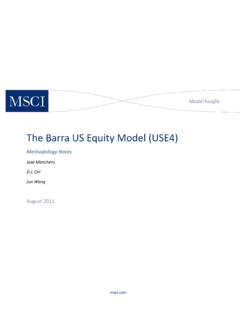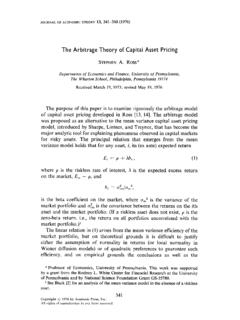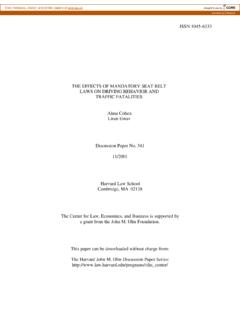Transcription of ISSN 1045-6333 HARVARD - Top1000Funds.com
1 Electronic copy available at: issn 1045-6333 HARVARD JOHN M. OLIN CENTER FOR LAW, ECONOMICS, AND BUSINESS LEARNING AND THE DISAPPEARING ASSOCIATION BETWEEN GOVERNANCE AND RETURNS Lucian A. Bebchuk, Alma Cohen, and Charles C. Y. Wang Discussion Paper No. 667 04/2010, Last revised 12/2011 Forthcoming, Journal of Financial Economics HARVARD Law School Cambridge, MA 02138 This paper can be downloaded without charge from: The HARVARD John M.
2 Olin Discussion Paper Series: The Social Science Research Network Electronic Paper Collection: This paper is also a discussion paper of the John M. Olin Center's Program on Corporate Governance Electronic copy available at: Forthcoming, Journal of Financial Economics Learning and the Disappearing Association between Governance and Returns Lucian A. Bebchuk,* Alma Cohen,** and Charles Wang** Abstract During the period 1991-1999, stock returns were correlated with the G-Index based on twenty-four governance provisions (Gompers, Ishii, and Metrick (2003)) and the E-Index based on the six provisions that matter most (Bebchuk, Cohen, and Ferrell (2009)).
3 This correlation, however, did not persist during the subsequent period 2000-2008. We provide evidence that both the identified correlation and its subsequent disappearance were due to market participants gradually learning to appreciate the difference between firms scoring well and poorly on the governance indices. Consistent with the learning hypothesis, we find that: (i) The disappearance of the governance-return correlation was associated with an increase in the attention to governance by a wide range of market participants; (ii) Until the beginning of the 2000s, but not subsequently, stock market reactions to earning announcements reflected the market s being more positively surprised by the earning announcements of good-governance firms than by those of poor-governance firms.
4 (iii) Stock analysts were also more positively surprised by the earning announcements of good-governance firms than by those of poor-governance firms until the beginning of the 2000s but not afterwards; (iv) While the G-Index and E-Index could no longer generate abnormal returns in the 2000s, their negative association with Tobin s Q and operating performance persisted; and (v) The existence and subsequent disappearance of the governance-return correlation cannot be fully explained by additional common risk factors suggested in the literature for augmenting the Fame-French-Carhart four-factor model.
5 Keywords: Corporate governance, governance indices, GIM, G-Index, E-Index, shareholder rights, entrenchment, market efficiency, learning, earning announcements, analyst forecasts, IRRC provisions, behavioral finance, asset pricing. JEL Classification: D03, G10, G12, G30, G34, K22 * HARVARD Law School and NBER. ** Tel-Aviv University Eitan Berglas School of Economics, HARVARD Law School, and NBER. ** Stanford University Department of Economics.
6 For helpful comments and reactions, we would like to thank an anonymous referee as well as Malcolm Baker, Bernie Black, Jesse Fried, Steve Kaplan, Andrew Metrick, Holger Mueller, Alan Schwartz, Guhan Subramanian, Jason Zweig, and participants in a HARVARD workshop. For financial support, we would like to thank the John M. Olin Center for Law, Economics, and Organization. Electronic copy available at: 1 1. Introduction In an influential paper, Gompers, Ishii and Metrick (2003) (hereinafter GIM) identified a governance-based trading strategy that would have produced abnormal profits during the period 1990-1999.
7 This strategy was based on a G-Index that GIM constructed on the basis of 24 governance provisions that weaken shareholder rights. These intriguing findings have attracted a great deal of attention ever since they were first reported, and the G-Index, as well as the E- Index that is based on a subset of these 24 provisions (Bebchuk, Cohen, and Ferrell, 2009), has been extensively used. As of March 2010, the GIM study has about 800 citations on SSRN. In this paper, we contribute to understanding GIM s celebrated results concerning the association between governance and abnormal returns.
8 We show that the G-Index (as well as the E-Index) was no longer associated with abnormal returns during the period of 2000-2008 (or any sub-periods within it), and we then investigate what explains both the existence of the governance-returns correlation during the 1990s and its subsequent disappearance. We identify several systematic differences between the 1990s and subsequent years and relate them to the disappearance of the governance-returns correlation. We provide evidence that is consistent with the hypothesis that both the existence and disappearance of the correlation were due to market participants learning to appreciate the difference between well-governed and poorly-governed firms.
9 GIM suggested that governance provisions or the characteristics of firms governance and culture that they reflect are associated with lower industry-adjusted Q, lower profits, lower sales growth, and more corporate acquisitions. Subsequent work found additional links between the G and E indices and firm performance. For example, Masulis, Wang and Xie (2007) find that worse G-Index and E-Index scores are correlated with worse acquisition decisions (as measured by the stock market returns accompanying acquisition announcements), and Dittmar and Mahrt-Smith (2007) find that worse scores are correlated with a less valuable use of cash holdings.
10 That the G-Index and E-Index are associated with lower firm value and worse firm performance, however, does not imply that these indices should be associated with abnormal stock returns, as GIM found for the period 1990-1999. To the extent that market prices already reflect fully the differences between well-governed and poorly-governed firms, trading on the basis of the governance indices should not be expected to yield abnormal profits. We conduct in this paper a series of tests for one possible explanation of the abnormal returns during the 1990s.












